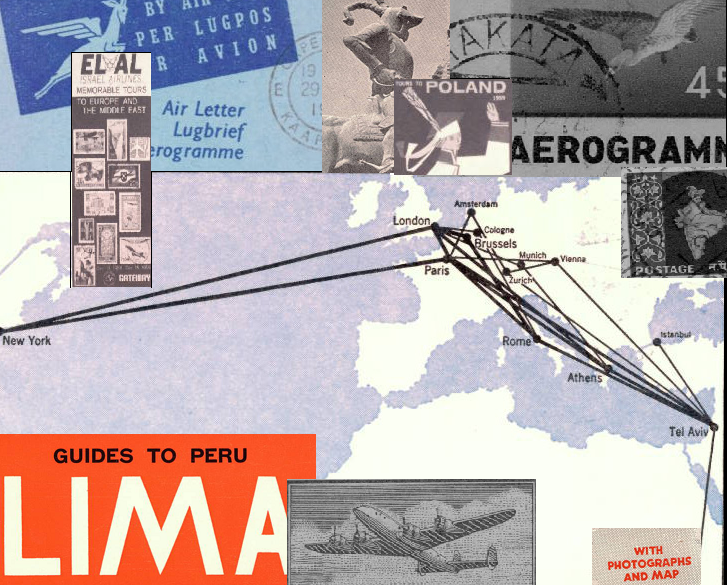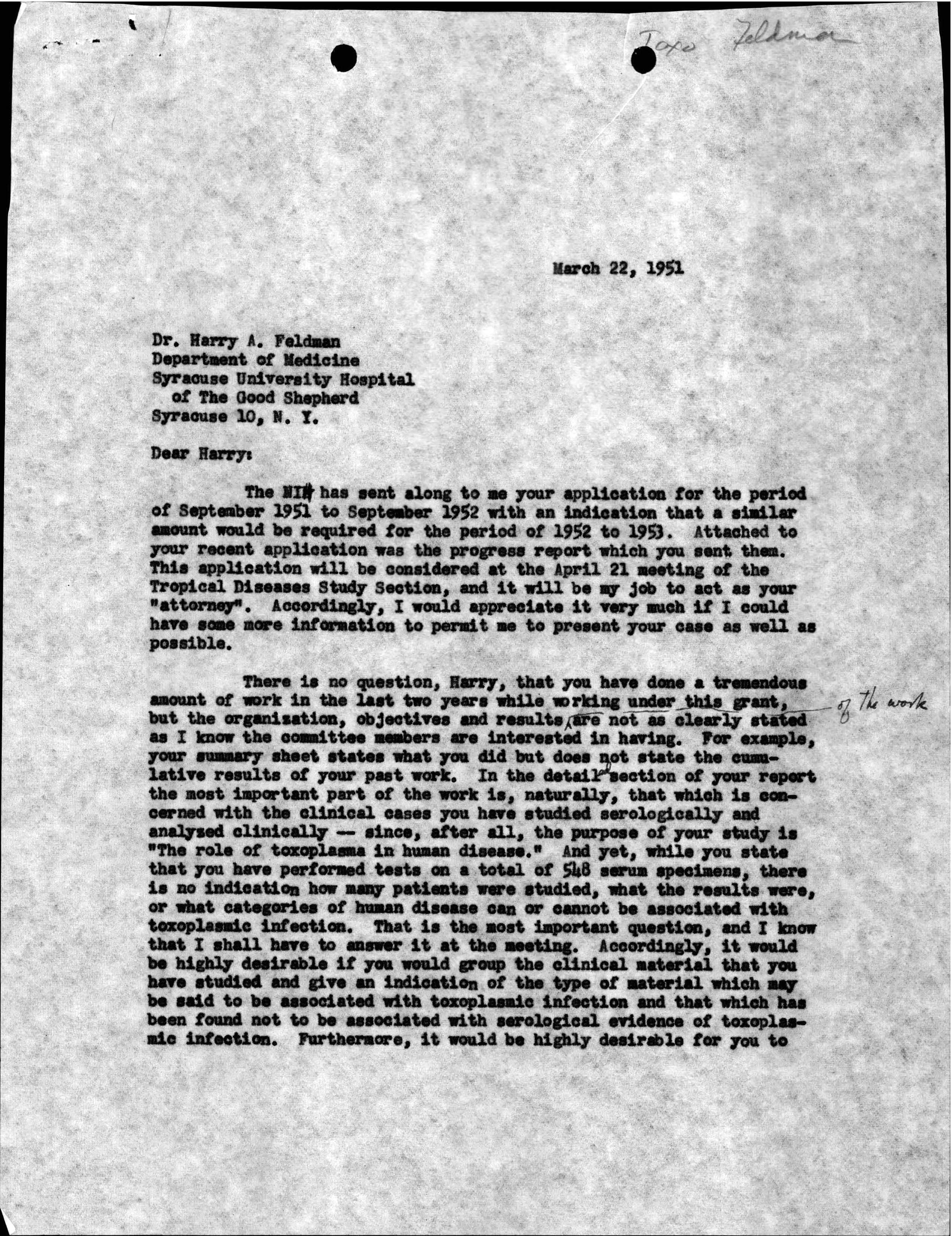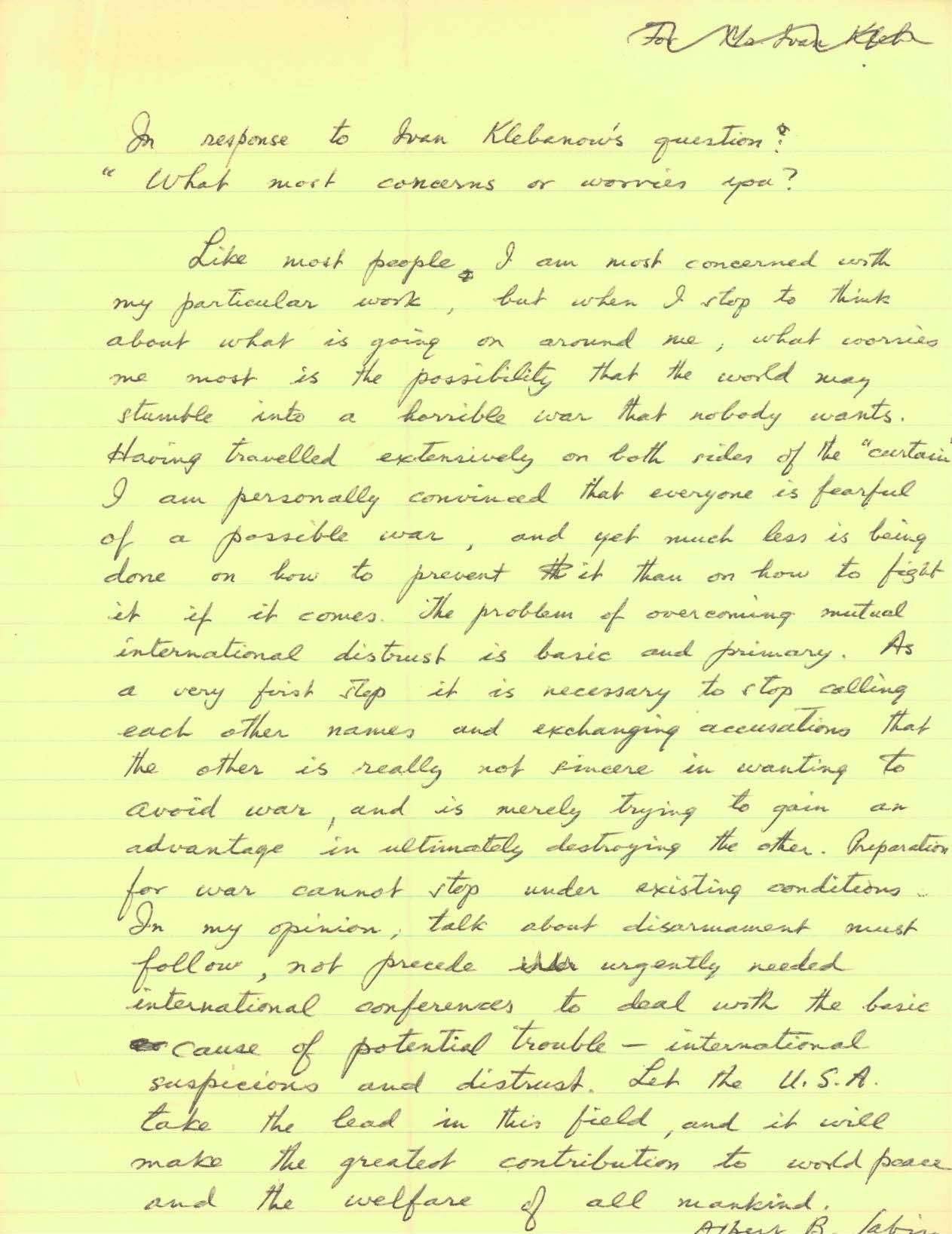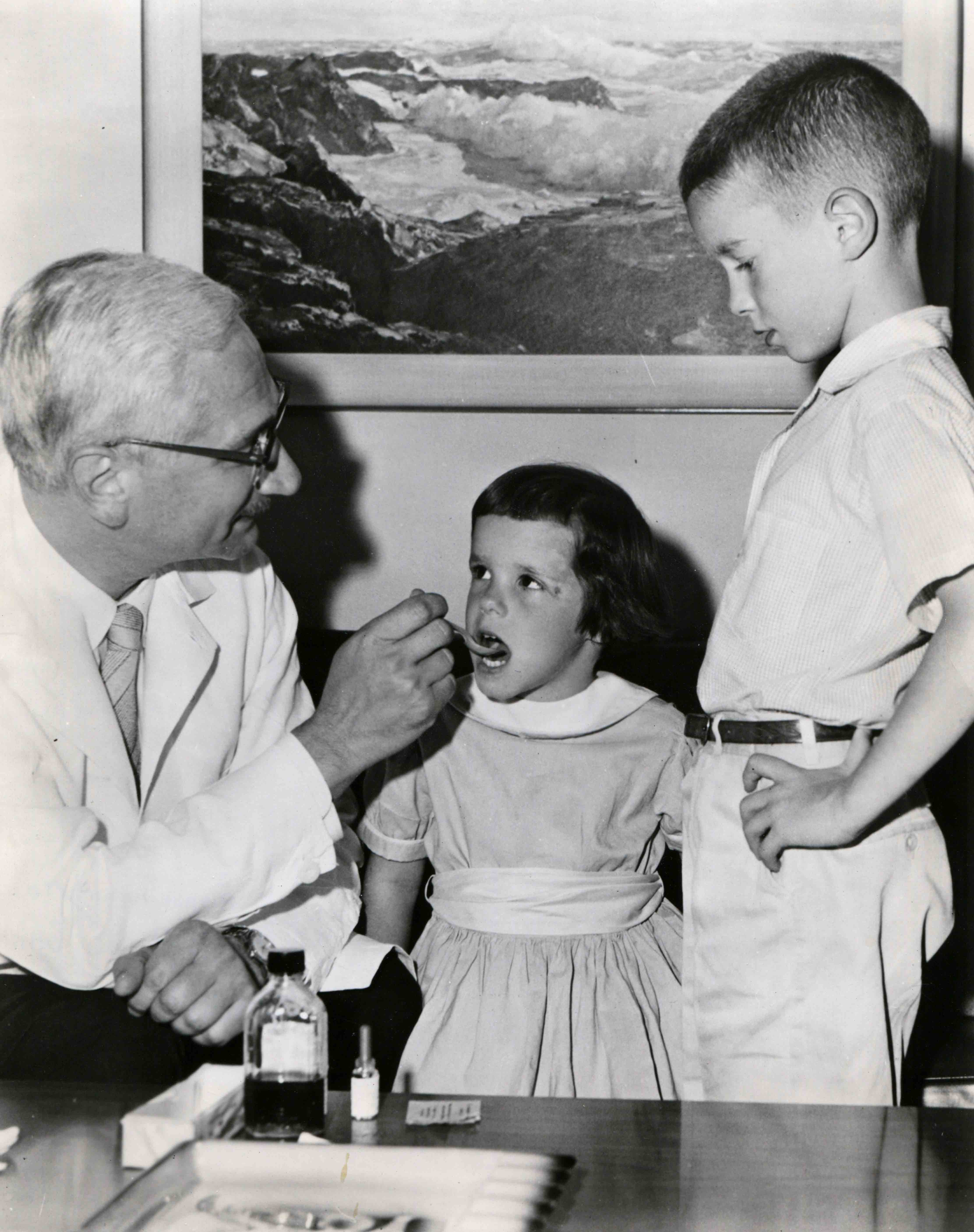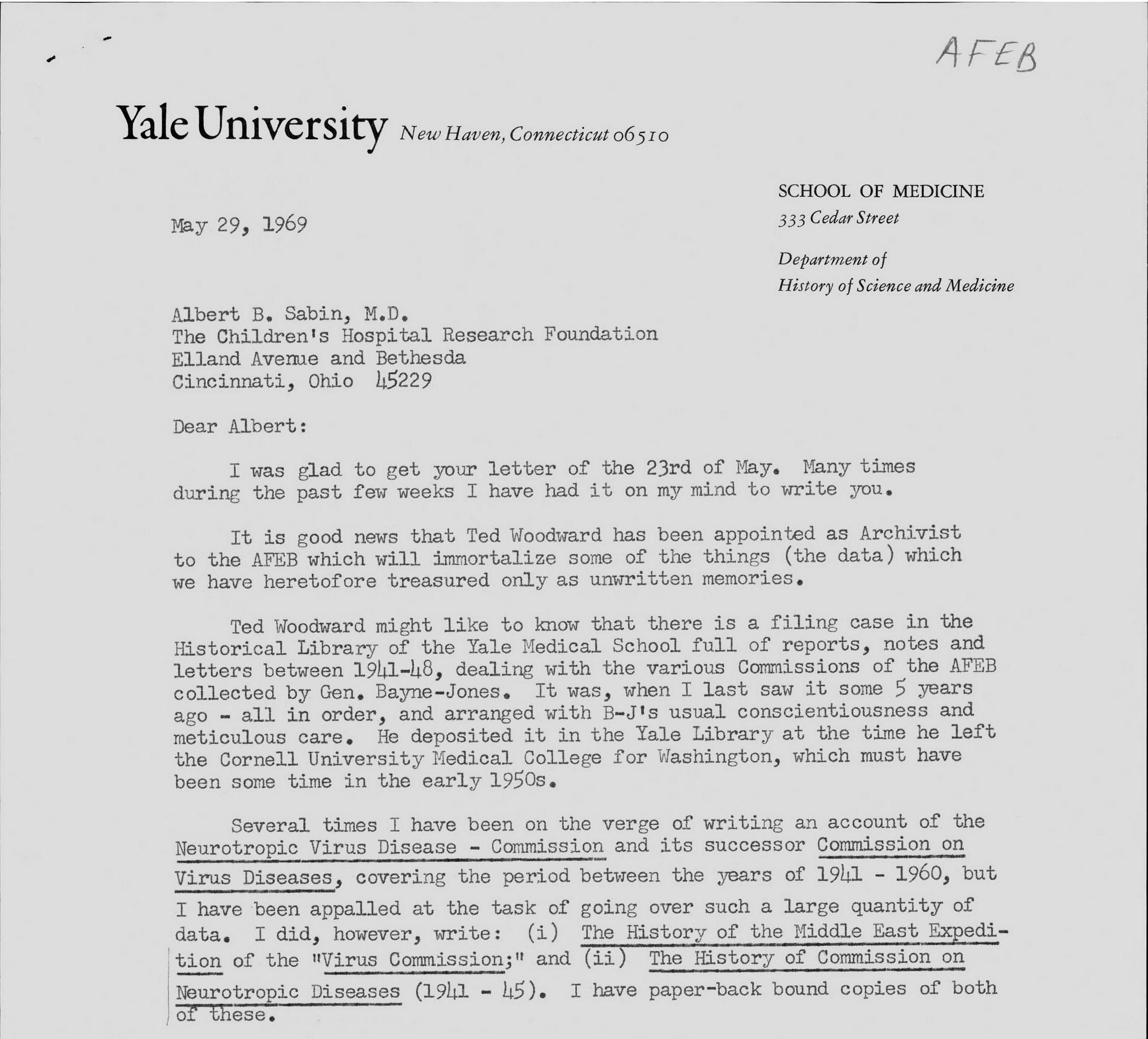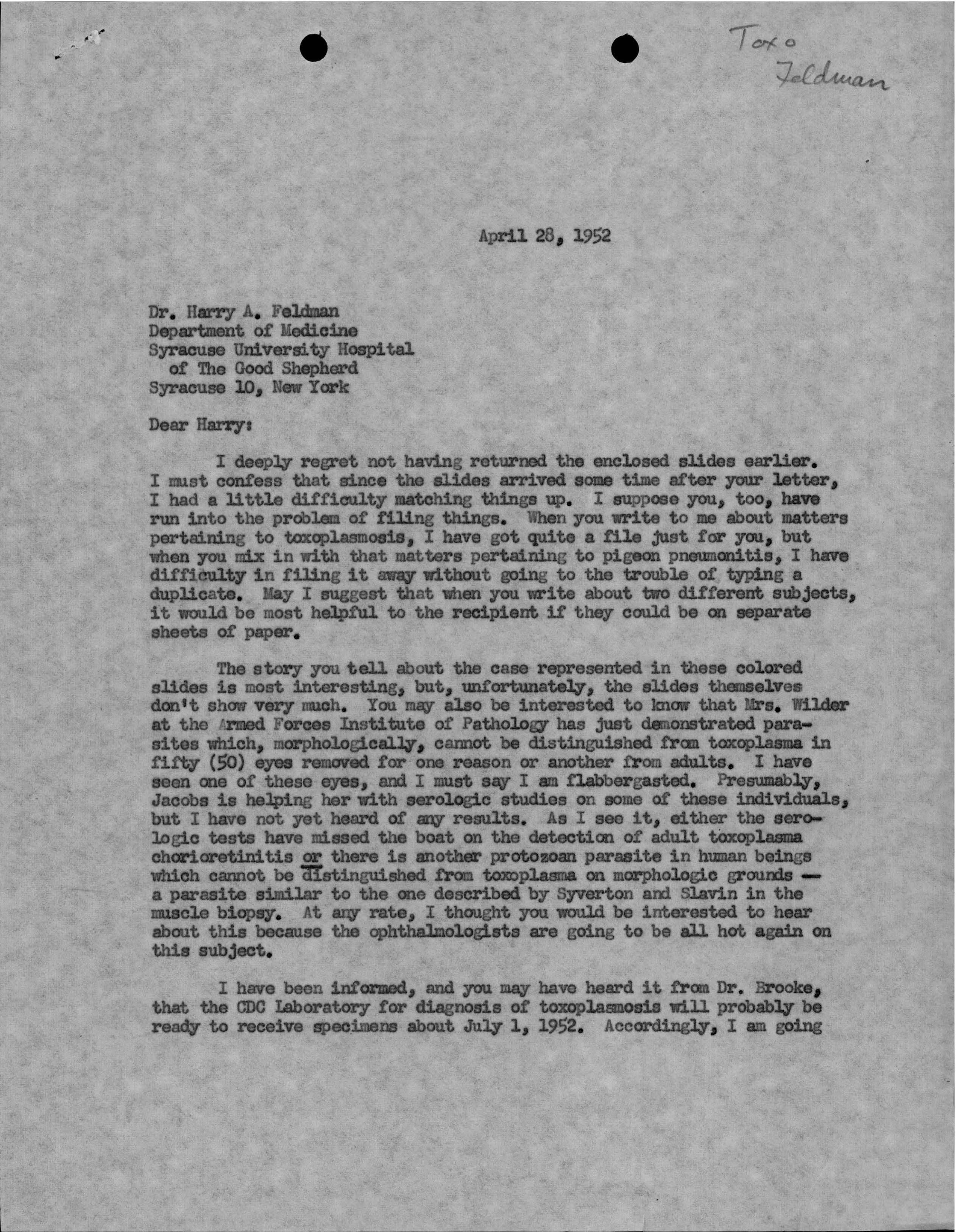An additional four years of the University of Cincinnati News Record has now been digitized, thanks to the generosity of a Bearcat alumnus. Jordan L. Bleznick, a 1976 A&S graduate, funded the project to digitize the student newspaper from 1973 through 1976, adding to the previous digitized issues from 1960 through 1970. Researchers can access these years by visiting the University of Cincinnati Digital Collections site at: http://digitalprojects.libraries.uc.edu/newsrecord/index.php. The newspapers are available as full-text and are keyword searchable. Continue reading
Category Archives: Digital Collections
The Albert B. Sabin Digitization Project: Example of Compassion and How It Influenced a Life
By Richard Jason Sookoor, Sabin Project Student Assistant
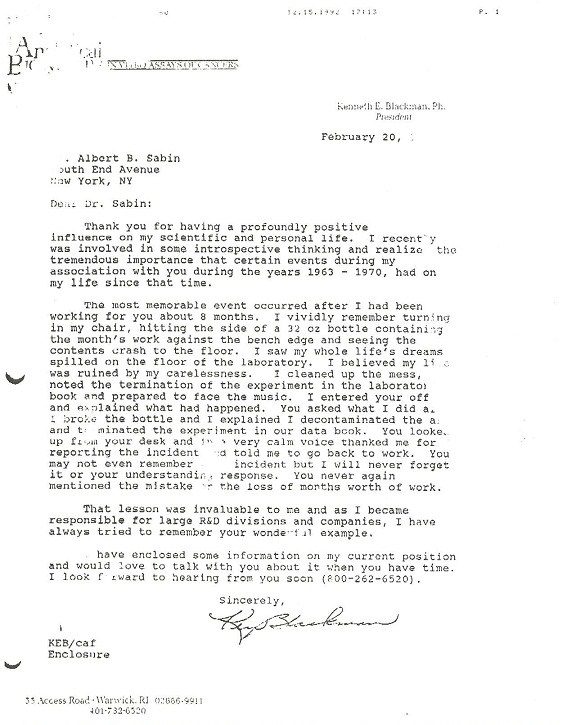
A letter written in 1992 to Dr. Sabin from Dr. Blackman regarding the incident roughly 30 years prior. Their correspondence over the next few months would last until Dr. Sabin's passing in 1993.
Successful people are often described as being driven, strong-willed, or zealous. Though to be definitively admirable, a person should also be compassionate, forgiving, and considerate. Dr. Albert Sabin managed to find a steady balance between these two domains, stern yet soft. In speaking with Dr. Kenneth Blackman, a former assistant to Dr. Sabin, we gain some insight on the level of professionalism and empathy shown by Dr. Sabin.
As the story goes, Dr. Blackman, then a young man with an opportunity to work in Dr. Sabin’s lab, was busy working on a project related to a potential human tumor virus. Dr. Blackman’s duties were to properly identify and collect concentrates in fluid from tissue culture infected with this particular virus. Despite the relatively cramped working space (Old Children’s Research Building R), Dr. Blackman was able to complete this rather standard collection with nary an incident for weeks. On a particular day though, a Friday, things took a heartbreaking turn for the worse. Dr. Blackman, completing the daily collection of concentrates from tissue culture, was steadily handling a bottle containing a few weeks’ worth of sample liquid. Bottle in hand, as he was turning towards away from the tissue culture station, the bottom of the bottle clipped the edge of the work bench causing the contents to fall out. Continue reading
The Albert B. Sabin Digitization Project: Dr. Sabin and His Travels
By: Richard Sookoor, Sabin Student Assistant
While perhaps never considering himself an adventurer, Dr. Sabin was surprisingly well traveled. Considering the span of his career, both military and academic, it might not seem unusual to visit quite so many different countries, though it is remarkable nonetheless.
Though he admits his adoration of living in the US, it seems the desire to travel was well within Dr. Sabin’s nature. Having traveled to at least 32 different countries* in his life, the opportunity to experience so many different cultures and lifestyles appears to have been well exploited. From cities as exotic as Dakar [1] and Bombay (at least in the 1960’s) to more contemporary locales like Stockholm and Paris, Dr. Sabin certainly realized the divergence of a (then) disconnected world. Continue reading
The Albert B. Sabin Digitization Project: "Do What I Preach and Not What I Practice"
One of my favorite letters that I have come across so far during this project is a 1951 letter from Dr. Sabin to his colleague Dr. Harry A. Feldman. In the letter, Dr. Sabin commented on a grant application Dr. Feldman sent to the National Institutes of Health. As usual, Dr. Sabin did not hold back his opinions on what could be done to improve the application. But in his letter, he also urged Dr. Feldman to write his material up for publication. He wrote:
[I]ndicate what it is you want to test, why, how many, where from, etc. If you don’t mind my saying so, Harry, the best way to achieve that is to outline one or more papers for publication and see what data you would like to have rounded out, get that data rounded out, and I will pray to God that ultimately you will write it up for publication. I can only say that I wish you would do what I preach and not what I practice myself. If you don’t write up the work you do over the years, it is work done for your own personal benefit and does not add to the sum total of scientific knowledge.[1] Continue reading
The Albert B. Sabin Digitization Project: What Worried Him Most
[Sabin Archivist’s Note: This week features the first blog post from Richard Sookoor, the Sabin Project student assistant. Richard is pursuing his Bachelor of Science degree in neurobiology from the McMicken College of Arts and Sciences here at the University of Cincinnati. He will be blogging on different Sabin-related topics as we work on the project. Please give Richard a warm welcome to the blogging world by reading his posts! -SB]
A typical opinion when speaking of scientists is that they are mostly entrenched in their work, sometimes unmindful of the world around them. However, for many scientists, their view of the world influences their research and scientific endeavors. Dr. Sabin proves to be a good example. Having been deployed to numerous conflict areas by the US Army Medical Corps during World War II, Dr. Sabin was well aware of the impact and outcomes of great wars. His experiences in these areas led him to pursue research focusing on dengue fever [1], Japanese B encephalitis [2], and sandfly fever [3] even after the completion of his military duty. Continue reading
The Albert B. Sabin Digitization Project: Check Us Out!
The Albert B. Sabin digitization project appeared in a couple of articles this week! I wanted to give you a heads-up on the articles from the National Endowment for the Humanities (NEH) and the Midwest Archives Conference (MAC), just in case you wanted to check them out for yourself.
The National Endowment for the Humanities article is the second part of a three part series featuring preservation and access projects that highlight medicine and the humanities. Joel Wurl, Senior Program Officer in the Division of Preservation and Access, wrote of the projects, “[T]he history of medicine bridges almost every domain of the humanities, from the study of philosophy and ethics to the examination of everyday social and cultural history. Far from being a narrow subfield of study, it opens a pathway for exploring some of the most fundamental questions of human experience over time.” The Hauck Center for the Albert B. Sabin Archives definitely fits into this description of the history of medicine. Not only does the Sabin collection cover the well-known topics associated with him, such as virology and vaccine development, but due to his involvement and interest in so many different areas, the collection also includes materials on many other topics. These include science and the media, medical ethics, public health, politics and science, military medicine, tropical medicine, medical imperialism, and international and scientific cooperation.
The Albert B. Sabin Digitization Project: More on the AFEB
As I continued to look through the administrative materials from the Armed Forces Epidemiological Board that are in the Sabin collection, I found a letter (seen to the right) from Dr. John R. Paul to Dr. Sabin that referred to the the appointment of an archivist for the Armed Forces Epidemiological Board to “immortalize some of the things (the data) which [they] have heretofore treasured only as unwritten memories.”[1] Naturally, as an archivist, I was intrigued by this appointment, especially because the members of the AFEB recognized that it was important to record their history for future generations. Continue reading
The Albert B. Sabin Digitization Project: Armed Forces Epidemiological Board

1963 - Letter from Cyrus R. Vance, Secretary of the Army, to Dr. Albert Sabin, confirming his appointment to the AFEB
The past couple of days I have been looking at administrative documents from Dr. Sabin’s time as a member of the Armed Forces Epidemiological Board (AFEB) during the 1960’s, to make sure there are no classified documents in this part of the collection. I thought I would share some things that I have encountered.
In 1963, Dr. Sabin was appointed a member of the AFEB based on a joint nomination by the Surgeons General of the Departments of the Army, Navy, and Air Force for a four year term (see letter to the right). As a member of the AFEB, Dr. Sabin was required to vote on contracts and commission appointments, as well as other issues applicable to military medicine. The memos and letters included in this part of the collection give insight into the issues addressed by the AFEB. They also provide researchers with information about Dr. Sabin’s opinions about these issues, through his own letters to other AFEB members and the notes he scribbled on the various memos he received. Topics included disease prevention and vaccination of troops. Here is just one example of Dr. Sabin’s involvement as a member of the AFEB.
Continue reading
The Albert B. Sabin Digitization Project: A Man after My Archivist Heart
Yesterday, my colleague Laura Laugle and I were discussing how to arrange archival collections, which reminded me of a letter (seen below) that I recently came across during the redaction process. I wanted to share this letter since I thought other archivists reading the blog would also appreciate it.
First, a little bit of explanation – one important task that archivists perform when they are processing a collection is referred to as “arrangement.” According to A Glossary of Archival and Records Terminology by Richard Pearce-Moses, arrangement is “the process of organizing materials with respect to their provenance and original order, to protect their context and to achieve physical or intellectual control over the materials.”[1] I realize that definition contains a lot of archival jargon, such as “provenance” and “original order.” Provenance, according to the same glossary, essentially refers to the person or organization that created the collection of materials.[2] Original order is the “organization and sequence of records established by the creator of the records,” which hopefully provides perspective into how the record creator used the materials.[3] Continue reading
The Albert B. Sabin Digitization Project at the Society of Ohio Archivists Annual Conference
Hello! I want to welcome our blog visitors from the Society of Ohio Archivists’ Annual Conference! Today, the University of Cincinnati Libraries’ Special Collections division is presenting during the 10:00am concurrent session:
We Look at Giants: The University of Cincinnati Archival Grant Projects
This session will look at two federal grant projects of University of Cincinnati special collections division, examining their implementation and the efforts at building diverse research audiences throughout the grant periods rather than at the conclusion of the projects. Important to the success of the grants is the concerted effort to develop outreach methods that effectively generate public support as the work progresses, and to clearly convey the national or international importance of the individuals whose papers were the subject of the grants. In this way, the sustainability of the projects and the preservation of the heritage they represent is strengthened for future research and pedagogical assignments from secondary through collegiate levels, as well as by professional scholars and journalists. Continue reading


